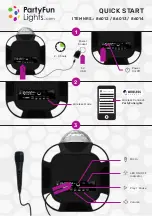
IMPORTANT SAFETY INFORMATION
Exposure to welding or cutting exhaust fumes can increase the risk of developing certain cancers, such
as cancer of the larynx and lung cancer. Also, some diseases that may be linked to exposure to welding
or cutting exhaust fumes are: • Early onset of Parkinson’s Disease • Heart disease • Ulcers
• Damage to the reproductive organs • Inflammation of the small intestine or stomach • Kidney damage
• Respiratory diseases such as emphysema, bronchitis, or pneumonia
2
TAMPING RAMMER USE AND CARE
Do not use near degreasing or painting operations.
Keep head out of fumes. Do not breathe exhaust fumes.
Use enough ventilation or exhaust, or both, to keep fumes and gases from breathing zone and
general area. If engineering controls are not feasible, use an approved respirator.
Work in a confined area only if it is well-ventilated, or while wearing an air-supplied respirator.
Have a recognized specialist in Industrial Hygiene or Environmental Services check the operation
and air quality and make recommendations for the specific welding situation. Follow OSHA guidelines
for Permissible Exposure Limits (PEL’s) and the American Conference of Governmental Industrial
Hygienists recommendations for Threshold Limit Values (TLV’s) for fumes and gases.
Wear ANSI-approved welding eye protection featuring at least a number 10 shade lens rating.
Wear leather leggings, fire resistant shoes or boots during use. Do not wear pants with
cuffs, shirts with open pockets, or any clothing that can catch and hold molten metal or sparks.
Keep clothing free of grease, oil, solvents, or any flammable substances. Wear dry, insulating gloves
and protective clothing.
Wear an approved head covering to protect the head and neck. Use aprons, cape, sleeves, shoulder
covers, and bibs designed and approved for welding and cutting procedures.
When welding/cutting overhead or in confined spaces, wear flame resistant ear plugs or ear muffs to
keep sparks out of ears.
Never leave the Spot Welder unattended while energized. Turn off and disconnect power when
leaving the work area.
Do not touch energized electrical parts. Wear dry, insulating gloves. Do not touch electrode or
conductor tong with bare hand. Do not wear wet or damaged gloves.
Connect to grounded, GFCI-protected 240V~ power supply only.
People with pacemakers should consult their physician(s) before use. Electromagnetic fields in close
proximity to heart pacemaker could cause pacemaker interference or pacemaker failure.
Do not expose welders to rain or wet conditions. Water entering a welder will increase the risk of
electric shock.
Do not abuse the cord. Never use the cord for carrying, pulling or unplugging the Welder. Keep cord
away from heat, oil, sharp edges or moving parts. Damaged or entangled cords increase the risk of
electric shock.
Insulate yourself from the work piece and ground. Use non-flammable, dry insulating material if possible,
or use dry rubber mats, dry wood or plywood, or other dry insulating material large enough to cover
your full area of contact with the work or ground.
Use care not to touch the welding tip to grounded material whenever the unit is plugged in. Electric
shock, fire, or burns may happen if appropriate precautions are not taken.
Summary of Contents for 55009
Page 10: ...TROUBLESHOOTING 9 ...





























